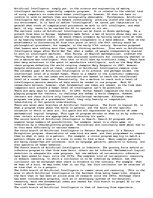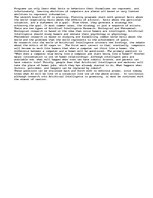-
Artificial Intelligence
Artificial Intelligence, simply put, is the science and engineering of making intelligent machines, especially computer programs. It is related to the similar task of using computers to understand human intelligence; however, AI does not have to confine it self to methods that are biologically observable. Furthermore, Artificial Intelligence has the ability to behave conditionally, altering itself and reacting to its environment. It is hard to define "intelligence"; we cannot yet characterize in general what kinds of computational procedures we wish to call intelligent, and what mark, if any, needs to be reached for AI to operate on its own.
The earliest roots of Artificial Intelligence can be found in Greek mythology. As a present from Zeus to Europa, Hepheastus made Talos, a man of bronze whose duty was to patrol the beaches of Crete. He would thwart invaders by hurling large rocks at them, or by heating himself red hot and squeezing trespassers in a warm embrace. Most of the advancements to discovering AI from this point on until the 20th century would be philosophical groundowrk; for example, in the early 17th century, Descartes proposed that humans were nothing more than complex thinking machines. True work on Artificial Intelligence began after World War Two, when a number of people independently started to work on intelligent machines. Alan Turing, an English mathematician, invented the "Turing Test" at this time, a test that discussed conditions for considering whether or not a machine was intelligent; this test is still used by scientists today. …
The title is simply "Artificial Intelligence." It is about Artificial Intelligence and the basic aspects of it, but does not go into great mathematical detail.


